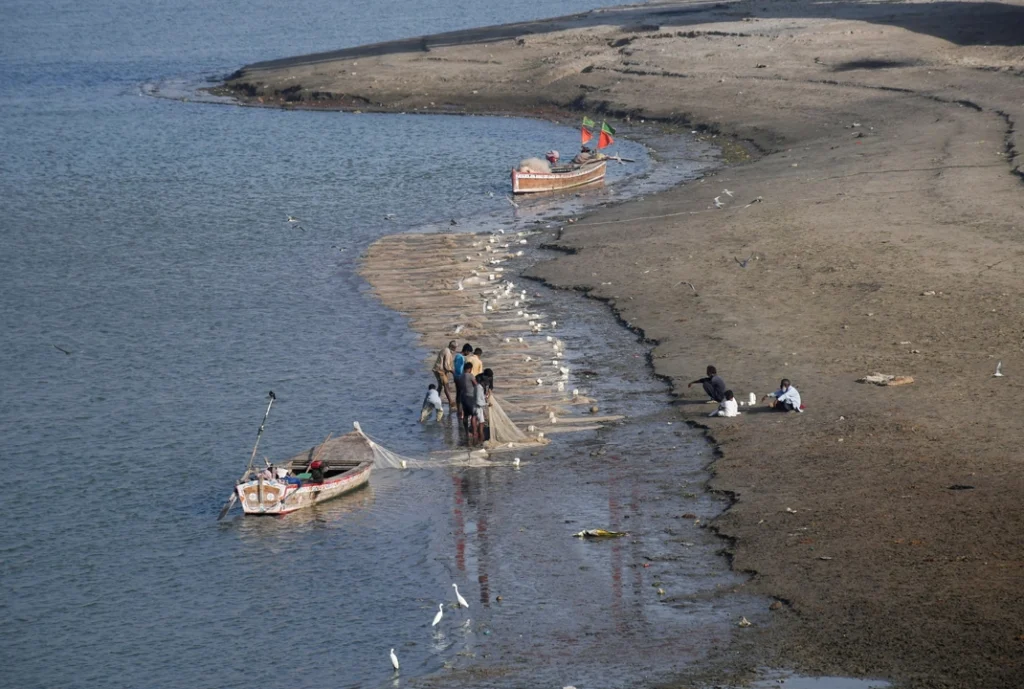- Reuters
- 33 Minutes ago

India weighs plan to slash Pakistan water supply with new Indus river project
-
- Reuters
- May 16, 2025

NEW DELHI/ISLAMABAD: India is considering plans to dramatically increase the water it draws from a major river that feeds Pakistani farms downstream, as part of retaliatory action for a deadly April attack on tourists that New Delhi blames on Islamabad, according to four people familiar with the matter.
Delhi suspended its participation in the Indus Waters Treaty of 1960, which governs usage of the Indus river system, shortly after 26 civilians in Indian Kashmir were killed in what India called an act of terror. Pakistan has denied involvement in the incident, but the accord has not been revived despite the two nuclear-armed neighbours agreeing a ceasefire last week following the worst fighting between them in decades.
Indian minister thanks Afghan Taliban for support
After the April 22 attack, Indian Prime Minister Narendra Modi ordered officials to expedite planning and execution of projects on the Chenab, Jhelum and Indus rivers, three bodies of water in the Indus system that are designated primarily for Pakistan’s use, six people told Reuters.
One of the key plans under discussion involves doubling to 120km the length of the Ranbir canal on the Chenab, which runs through India to Pakistan’s agricultural powerhouse of Punjab, two of the people said. The canal was built in the 19th century, long before the treaty was signed.
India is permitted to draw a limited amount of water from the Chenab for irrigation, but an expanded canal – which experts said could take years to construct – would allow it to divert 150 cubic meters of water per second, up from about 40 cubic meters currently, the four people said, citing official discussions and documents they had seen.
Details of the Indian government’s deliberations on expanding Ranbir have not previously been reported. The discussions started last month and continue even after the ceasefire, one of the people said.
The Indian ministries responsible for water and foreign affairs, as well as Modi’s office, did not respond to Reuters’ questions. Indian hydropower giant NHPC, which operates many projects in the Indus system, also did not respond to an email seeking comment.
Modi said in a fiery speech this week that “water and blood cannot flow together,” though he didn’t refer to the treaty. Indian foreign ministry spokesperson Randhir Jaiswal told reporters Tuesday that India “will keep the treaty in abeyance until Pakistan credibly and irrevocably abjures its support for cross-border terrorism”.
The water and foreign ministries of Pakistan did not respond to requests for comment. Foreign Minister Ishaq Dar told lawmakers this week that the government had written to India arguing that suspending the treaty was unlawful and that Islamabad regarded it as remaining in force.
Islamabad said after India suspended the treaty in April that it considered “any attempt to stop or divert the flow of water belonging to Pakistan” to be an “act of war.”
About 80 per cent of Pakistani farms depend on the Indus system, as do nearly all hydropower projects serving the country of some 250 million.
Any efforts by Delhi to build dams, canals or other infrastructure that would withhold or divert significant amount of flow from the Indus system to India “would take years to realize,” said water security expert David Michel of the Washington-based Center for Strategic and International Studies.
Pakistan-India war: Battle-hardened PAF pilots to appear on TV
But Pakistan has had a preview of the kind of pressure it could face from India: Water at a key receiving point in Pakistan briefly fell by as much as 90 per cent in early May after India started maintenance work on some Indus projects.
SUCCESS THREATENED
The Indus system runs through some of the world’s most geopolitically tense areas, originating near Lake Mansarovar in Tibet and snaking through India’s north and Pakistan’s east and southeast, before emptying into the Arabian Sea.
The treaty is widely seen as one of the world’s most successful water-sharing accords, having survived several major wars and longstanding tensions between India and Pakistan.
Islamabad has previously opposed many Indian projects in the Indus system, while Delhi said after the Kashmir attack that it had been trying to renegotiate the treaty since 2023 to account for population increases and its rising need for clean hydroenergy.
The treaty restricts India largely to setting up low-impact hydropower projects on the three rivers allocated to Pakistan. Delhi has freedom to utilize the waters of three other rivers – the Sutlej, Beas and Ravi tributaries – as it sees fit.
Alongside the plans to expand Ranbir canal, India is also considering projects that would likely reduce the flow of water into Pakistan from rivers allocated to that country, according to two government documents seen by Reuters and interviews with five people familiar with the matter.
One document, an undated note prepared by a government company for officials considering irrigation plans, suggests that water from the Indus, Chenab and Jhelum “potentially be distributed into rivers” in three northern Indian states.
One of the people said the document, the details of which haven’t been previously reported, was created for discussions with power ministry officials after the April 22 attack.
Delhi has also created a list of hydropower projects in its Jammu and Kashmir territory that it hopes will expand capacity to 12,000 megawatts, up from the current 3,360 MW.
India revokes Celebi security clearance over Turkish support for Pakistan
The list, which was created by the power ministry and seen by Reuters, was not dated. A person familiar with the document said it was created before the Kashmir incident but is actively being discussed by government officials.
The prospective projects also include dams that can store large volumes of water, in what would be a first for India in the Indus river system, according to two people familiar with the matter.
India has identified at least five possible storage projects, four of which are on tributaries of the Chenab and Jhelum, according to the power ministry document.
POLITICAL WRANGLING
The Himalayan region of Kashmir is claimed by both India and Pakistan, though each controls only parts of the area.
The region has been ravaged by an anti-India insurgency for decades, which Delhi has accused Islamabad of fuelling and funding. Pakistan denies the charges.
International relations expert Happymon Jacob at Delhi’s Jawaharlal Nehru University said that India’s new focus on the Indus Waters Treaty reflected an attempt to pressure Pakistan over Kashmir.
“With the latest conflict, Delhi may refuse to discuss Kashmir with Pakistan in any format,” he said. “Delhi has not only progressively narrowed the scope of bilateral talks but has also curtailed the agenda, focusing only on specific issues like the IWT.”
Pakistan has said that it is preparing legal action in several international forums, including the World Bank, which facilitated the treaty, as well as the Permanent Court of Arbitration or the International Court of Justice in The Hague.
“Water should not be weaponised,” Pakistan’s Finance Minister Muhammad Aurangzeb told Reuters on Monday. “We don’t even want to consider any scenario which … does not take into account the reinstatement of this treaty.”
Michel, the US-based expert, said that concern over the treaty’s suspension was not limited to Islamabad.
“As geopolitical competition across the region deepens, more than a few Indian observers fear that Delhi’s use of water against Islamabad risks licensing Beijing to adopt the same strategy against India,” he said.
WHAT IS THE INDUS WATERS TREATY BETWEEN INDIA AND PAKISTAN?
India suspended its participation in the Indus Waters Treaty with Pakistan last month after the killing of 26 civilians in Kashmir, which New Delhi blames on Islamabad. Pakistan denies the charges, which led to the worst fighting between the countries in decades before a ceasefire was agreed last week.
The treaty had survived three wars and other conflicts between the bitter rivals, while withstanding many twists and turns in diplomatic ties. Reuters reported on May 16 that Delhi is considering projects that would likely reduce the flow of water into Pakistan from rivers allocated to that country.
India says it will “keep the treaty in abeyance until Pakistan credibly and irrevocably abjures its support for cross-border terrorism,” while Islamabad says “any attempt to stop or divert the flow of water belonging to Pakistan” will be an “act of war.”
WHAT IS THE INDUS WATERS TREATY?
The nuclear-armed neighbours disagree over use of the water from rivers that flow downstream from India into the Indus river basin in Pakistan.
The use of the water is governed by the Indus Waters Treaty, which was mediated by the World Bank and signed by the neighbours in September 1960.
The agreement split the Indus and its tributaries between the two countries and regulated water sharing. India was granted the use of water from three eastern rivers – Sutlej, Beas and Ravi – while Pakistan was granted most of the three western rivers – Indus, Jhelum and Chenab.
There is no provision in the treaty for either country to unilaterally suspend or terminate the pact, which has clear dispute resolution systems.
WHAT ARE THE CONCERNS OVER WATER?
The countries have argued over and disputed several projects on the Indus and its tributaries for years.
Pakistan is heavily dependent on water from this river system for its hydropower and irrigation needs. Pakistan says India unfairly diverts water with the upstream construction of barrages and dams, a charge India denies.
Pakistan is concerned that India’s dams will cut flows on the river, which feeds 80 per cent of its irrigated agriculture. It has asked for a neutral expert and then an arbitration court to intervene in two recent hydropower projects.
India has accused Pakistan of dragging out the complaints process, and says the construction of its Kishanganga and Ratle hydroelectric projects is allowed under the treaty. It has also sought modification of the pact to get around such delays.
WHAT COULD THE SUSPENSION CHANGE?
The suspension of the accord is not expected to have an immediate impact on the flow of water to Pakistan as India does not have enough storage capacity. However, water at a key receiving point in Pakistan briefly fell by as much as 90 per cent in early May after India started maintenance work on some Indus projects.
India’s move could also bring uncertainty to Pakistan’s agricultural system.
Pakistan’s response will be brutal, if India violates ceasefire: ISPR
The suspension means India can stop sharing crucial information and data on release of water from barrages/dams or on flooding, Indian officials said, adding that New Delhi will also not be obliged to release minimum amounts of water during the lean season.
HOW HAS PAKISTAN REACTED TO THE DECISION?
Pakistan says the treaty is a binding international agreement brokered by the World Bank and contains no provision for unilateral suspension.
Ghasharib Shaokat, the head of product at Pakistan Agriculture Research, called the treaty the backbone of the country’s agriculture sector.
“It puts our agricultural future on shaky ground. If water flows become erratic, the entire system takes a hit — especially irrigation-dependent crops such as wheat, rice, and sugarcane,” Shaokat said.
“Yields could drop. Costs could rise. Food prices would likely spike. And small-scale farmers, who already operate on thin margins, would bear the brunt of it.”
Khalid Hussain Baath, chairman of a national farmers’ union in Pakistan, painted the move as an act of belligerence.
“This is a true war,” Baath said from Lahore. “We already have a water shortage because of climate change. Low rainfall this year, and limited snow means that the water level is already 20-25 per cent lower than last year.”






